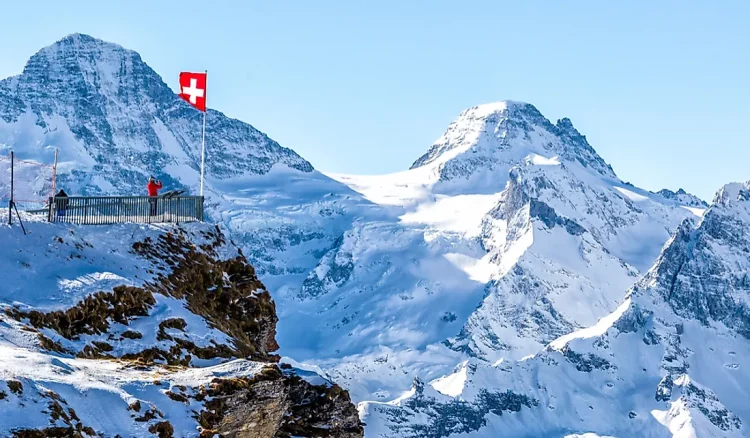Overview of the Swiss Alps as a Natural Wonder
The Swiss Alps, one of the most iconic mountain ranges in the world, offer a stunning display of nature’s grandeur. Stretching across the southern part of Switzerland, these mountains are not only a geographical wonder but also a symbol of Swiss identity and pride. Towering peaks, lush green valleys, crystal-clear lakes, and vibrant alpine meadows make the Swiss Alps a paradise for nature enthusiasts and travelers alike.
The Swiss Alps are home to some of Europe’s highest peaks, including the famous Matterhorn, a towering pyramid-shaped mountain that has become an emblem of Switzerland itself. With over 1,200 peaks reaching over 4,000 meters, the Alps offer dramatic landscapes that vary from sharp, jagged summits to serene valleys dotted with picturesque villages.
But the significance of the Swiss Alps extends beyond their physical beauty. The mountains have shaped the history, culture, and way of life of the Swiss people for centuries. From the medieval era to modern times, the Alps have influenced everything from architecture to agriculture and from art to daily life. The deep connection between the Swiss people and the mountains is evident in their cultural practices, festivals, and customs, which reflect the importance of the mountains in their lives.
The Swiss Alps are also a hub for outdoor activities, from skiing and snowboarding in the winter to hiking, cycling, and mountaineering in the summer. This strong link between nature and outdoor sports has created a culture of sustainability, with local communities working to preserve the natural environment while embracing the benefits of tourism.
The Cultural Practices Linked to Mountain Life, Including Cheese-making and Alpine Festivals
For centuries, the Swiss Alps have not only served as a natural fortress for the Swiss people but have also shaped their customs and way of life. The mountain landscape is an integral part of Swiss culture, and many of the country’s most important traditions and customs are rooted in alpine life.
One of the most notable practices tied to the Swiss Alps is cheese-making. The Swiss have long been known for their exceptional cheese, and the mountains play a key role in this tradition. The practice of making cheese in the Alps is a centuries-old craft, and the cows grazing in the high meadows produce milk that is used to make some of the world’s best cheeses, such as Gruyère and Emmental. Every summer, farmers in alpine villages engage in the tradition of Alpabzug (or “cattle descent”), where herders lead their cattle down from the high mountain pastures to the valleys below. The cheese produced from this high-altitude milk is renowned for its unique flavor, and the Alp cheese festivals are celebrated across the region, drawing tourists and locals alike.
Cheese-making in the Swiss Alps is not just about creating delicious dairy products; it is an art form and a cultural symbol. The practice is closely tied to the alpine lifestyle, with each region having its own specialty cheese and traditional methods. The process is a family tradition passed down from generation to generation, and it continues to be an important part of the cultural heritage of the Swiss people.
The Alps also provide the perfect backdrop for alpine festivals, which celebrate both the natural beauty of the region and the traditions of mountain life. One of the most famous of these is the Fête de l’Escalade, held in the city of Geneva. This historic festival commemorates the victory of the city’s defenders over an invading army in 1602. During the festival, people dress in medieval costumes, participate in processions, and enjoy traditional foods and music.
In smaller villages, festivals celebrate the arrival of summer with processions and fairs that showcase local crafts, music, and food. The Swiss National Day on August 1st is another major cultural celebration in the Swiss Alps, where locals gather for fireworks, barbecues, and patriotic ceremonies. These festivals serve as an opportunity for the Swiss people to celebrate their culture and history, and they provide visitors with a chance to experience the rich traditions of the Alps firsthand.
How Swiss Culture Celebrates Nature Through Music, Dance, and Festivals
Swiss culture has always had a deep reverence for nature, and this is reflected in the music, dance, and festivals that take place throughout the Swiss Alps. From the peaceful sounds of Alpine horns to the lively rhythms of traditional dances, Swiss music celebrates the beauty and tranquility of the mountains.
One of the most distinctive elements of Swiss culture is the Alphorn, a long wooden horn that has been used for centuries in the mountains. Traditionally played by herders, the Alphorn is used to communicate across vast distances in the Alps. The sound of the Alphorn is haunting and resonates throughout the mountains, symbolizing the deep connection between the people and the land. Today, the Alphorn is often featured at festivals and performances, where it is played alongside other traditional instruments such as the Swiss accordion.
Another important element of Swiss cultural celebrations is folk dance. Many Swiss villages have their own traditional dances, which are often performed at festivals and community events. These dances are typically energetic and lively, reflecting the joy and celebration of mountain life. In the Swiss Alps, dance is a social activity that brings people together to celebrate the seasons, the harvest, and the natural beauty of the mountains.

Best Places to Visit in the Alps: Zermatt, Grindelwald, Interlaken
The Swiss Alps are home to some of the most breathtaking destinations in the world. Whether you’re an avid adventurer or simply someone who wants to soak in the beauty of the mountains, the Swiss Alps offer a variety of options for exploration. Some of the best places to visit include Zermatt, Grindelwald, and Interlaken.
Zermatt is perhaps the most famous destination in the Swiss Alps, known for its iconic Matterhorn mountain, which attracts climbers, skiers, and photographers from around the world. The town of Zermatt itself is car-free, preserving its charming, alpine atmosphere. Visitors can take the Gornergrat Railway to reach the summit of the Gornergrat mountain for stunning views of the Matterhorn, or they can hike through the picturesque alpine meadows that surround the town.
Grindelwald is another must-visit destination for those looking to experience the beauty of the Swiss Alps. Nestled in a lush valley surrounded by towering peaks, Grindelwald is a popular base for outdoor activities such as hiking, skiing, and mountaineering. From Grindelwald, visitors can take the Jungfrau Railway to reach the Jungfraujoch, the “Top of Europe,” where they can enjoy panoramic views of the surrounding glaciers and snow-capped peaks.
Interlaken is located between two lakes, Lake Thun and Lake Brienz, and is surrounded by the towering peaks of the Bernese Oberland. Interlaken is known for its adventurous spirit, offering a wide range of outdoor activities, including paragliding, skydiving, and hiking. It is also a gateway to the famous Schilthorn and Jungfraujoch mountains, where visitors can experience some of the most spectacular views in Switzerland.
Tips for Traveling Through the Swiss Alps and Engaging with Local Traditions
Traveling through the Swiss Alps is an unforgettable experience, but it’s important to approach your visit with respect for the local culture and environment. Here are some tips to help you make the most of your trip:
- Respect Local Customs: The Swiss Alps are home to many small villages and communities, and it’s important to be respectful of their way of life. When attending festivals or events, make an effort to learn about the traditions and customs of the area. Participate in the celebrations, but always be mindful of the local norms and etiquette.
- Engage with Local Farmers and Artisans: One of the best ways to experience Swiss culture is through its food and craft. Many Swiss villages have local farms and cheese producers who welcome visitors. Consider taking a guided tour of a cheese dairy or participating in an Alpabzug festival to learn more about the traditions of cheese-making and alpine life.
- Take Part in Outdoor Activities: The Swiss Alps offer a wealth of outdoor activities, from skiing in the winter to hiking and cycling in the summer. Whether you’re an experienced mountaineer or a casual hiker, there are trails and routes suitable for all levels. Be sure to pack appropriately for the weather and terrain, and always follow safety guidelines when engaging in outdoor activities.
- Practice Sustainable Tourism: The Swiss Alps are a pristine natural environment, and it’s essential to preserve this beauty for future generations. Be conscious of your environmental impact, especially when visiting remote areas. Stick to marked trails, avoid littering, and support eco-friendly accommodations and services that prioritize sustainability.
Conclusion
The Swiss Alps offer more than just breathtaking landscapes; they are a place where nature and culture are intricately woven together. The mountains are not only a source of natural beauty but also a foundation for the customs, traditions, and daily lives of the Swiss people. From cheese-making to festivals, from folk music to outdoor activities, the Swiss Alps offer a unique blend of cultural heritage and natural wonder. By respecting the traditions of the region and engaging with the local culture, visitors can experience the true essence of the Swiss Alps while enjoying all the natural beauty they have to offer.





















